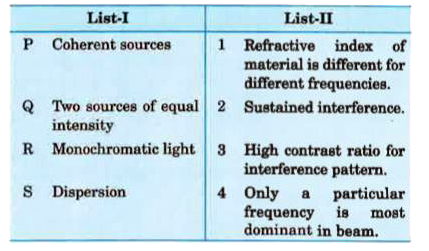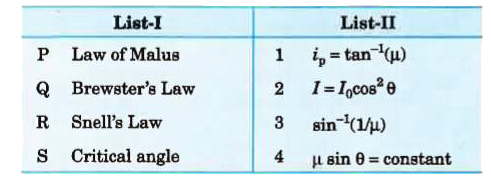This section contains a paragraph. Based upon this paragraph, three multiple- choice question (21-23) have to be answered. Each question has four choices (a,b,c and d), out of which only one is correct.
The result obtained in electrostatics using Gauss's law can in same cases be used to obtain result in gravitational, and vice versa. This is because both follow the inverse- square law of distance. We use of the following three rules
(1) For charge in electrostatics, the corresponding quantity in gravitation is mass.
(2) Electric intensity of electrostatics corresponds to gravitational intensity, or acceleration due to gravity, in gravitation.
(3)The constant k=(4πε0)−1 of electrostatics corresponds to -G in gravitation.
The gravitation intensity near a thin infinite sheet wiht mass σ per unit area has the magnitude
4πGσ
(1/4π)Gσ
2πGσ
2πσ/G
The correct Answer is:C
Topper's Solved these Questions
- PRACTICE WORKSHEET 1BOOK - D MUKHERJEECHAPTER - PRACTICE WORKSHEET 1EXERCISE - Matrix-Matching Type
1 Videos
- PRACTICE WORKSHEET 1BOOK - D MUKHERJEECHAPTER - PRACTICE WORKSHEET 1EXERCISE - Assertion- Reason Type
3 Videos
- OPTICSBOOK - D MUKHERJEECHAPTER - OPTICSEXERCISE - All Questions
47 Videos
- PRACTICE WORKSHEET 2BOOK - D MUKHERJEECHAPTER - PRACTICE WORKSHEET 2EXERCISE - Linked- Comprehension Type
4 Videos
Similar Questions
Knowledge Check
This section contains a paragraph. Based upon this paragraph, three multiple- choice question (21-23) have to be answered. Each question has four choices (a,b,c and d), out of which only one is correct.
The result obtained in electrostatics using Gauss's law can in same cases be used to obtain result in gravitational, and vice versa. This is because both follow the inverse- square law of distance. We use of the following three rules
(1) For charge in electrostatics, the corresponding quantity in gravitation is mass.
(2) Electric intensity of electrostatics corresponds to gravitational intensity, or acceleration due to gravity, in gravitation.
(3)The constant k=(4πε0)−1 of electrostatics corresponds to -G in gravitation.
The gravitational intensity at a distance r from a long thread having λ mass per unit length has the magnitudeAλG/rB2λG/rCλG/2rDλG/2πrThis section contains a paragraph. Based upon this paragraph, three multiple- choice question (21-23) have to be answered. Each question has four choices (a,b,c and d), out of which only one is correct.
The result obtained in electrostatics using Gauss's law can in same cases be used to obtain result in gravitational, and vice versa. This is because both follow the inverse- square law of distance. We use of the following three rules
(1) For charge in electrostatics, the corresponding quantity in gravitation is mass.
(2) Electric intensity of electrostatics corresponds to gravitational intensity, or acceleration due to gravity, in gravitation.
(3)The constant k=(4πε0)−1 of electrostatics corresponds to -G in gravitation.
The acceleration dut to gravity at the surface of the earth is g, and at a distance r from the centre of the earth is gr/R, where R is the radius of the earth. Inside a uniformly charged sphere of radius R and charge Q, the electric intensity at a distance r (r<R) from the centre has the magnitudeAkQ{1−(r/R)2}BkQr/R3CkQR/r3DkQ(R−r)/R3This section contains 1 paragraph. Based on paragraph, there are 3 questions. Each question has 4 choices (1), (2), (3), (4) out of which only one is correct
Q. If F(x) is continuous at x=−1, thenAa+b=−2Ba−b=3Ca2=b2+5Da+b=5
Here paragraph is given Based upon this paragraph some mutiple choice question are given.Each question has 4 choices A,B,C and D.out of which one is correct the correct option.
Paragraph/Comprehension−I
Oil spilt is
View SolutionThis section contains 1 paragraph. Based on paragraph, there are 3 questions. Each question has 4 choices (1), (2), (3), (4) out of which only one is correct
Q. if F(x) is continuous at x=±1, then f(x)=g(x) has
View SolutionEach question has matching list. The codes for the lists have choices (a), (b) , (c) and (d), out of which only one is correct.

View SolutionEach question has matching list. The codes for the lists have choices (a), (b) , (c ) and (d), out of which only one is correct.

View SolutionHere paragraph is given Based upon this paragraph some mutiple choice question are given.Each question has 4 choices A,B,C and D.out of which one is correct the correct option.
Paragraph/Comprehension−I
Major source of oil pollution of sea water is
View Solution
